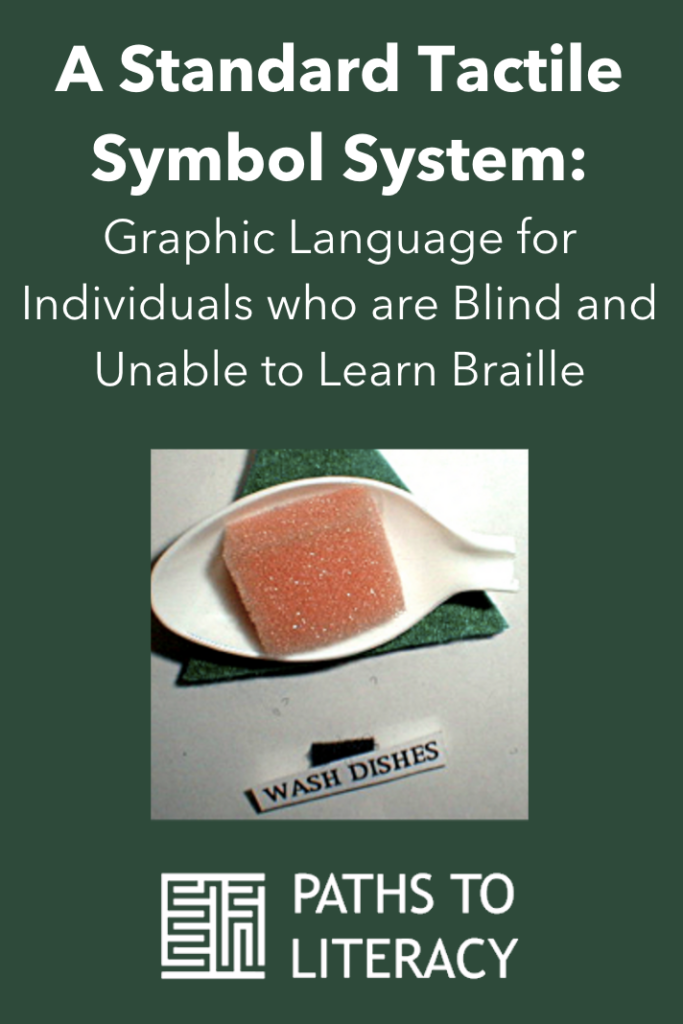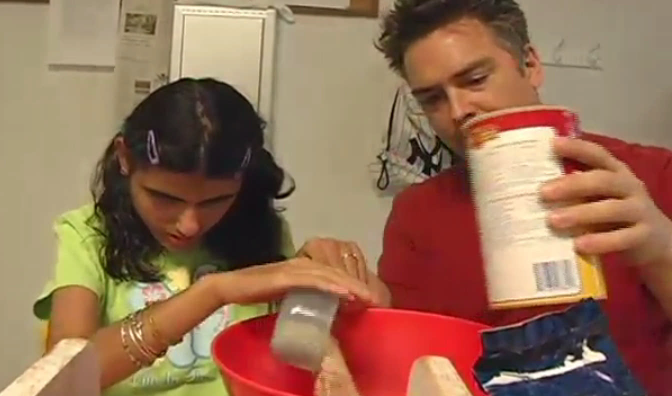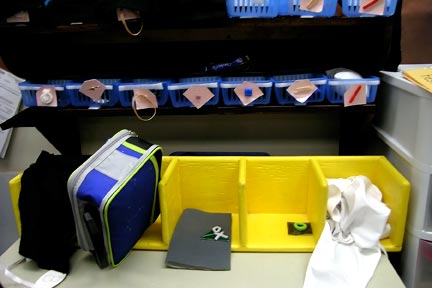Pictures are often used as a graphic form of communication (a map, a chart, etc.) for individuals who have adequate residual vision. Tactile symbols are concrete representations developed for individuals who are totally blind or function as if they were totally blind and who have a practical need for a graphic language system. The system described here has been developed by the instructional staff in the Life Skills Department at Texas School for the Blind and Visually Impaired in Austin Texas, and has been piloted with students in the program who are blind and deaf-blind. The tactile symbol system differs from the “textured communication symbols,” described by Bailey (1992). It is standardized and linguistically-based. It also requires the individual using the symbols to have specific skills in the areas of communicative intent and symbolic development.
Tactile symbols can serve the same purposes as pictures. The background is coded by shape and texture to represent different meaning categories (see Chart 1). This helps the student and teachers organize the symbols by meaning categories. The shape and texture of the background give perceptual cues. For example the oval made of laminated plain poster board represents objects and the square made of needlepoint backing represents locations. Objects are glued to the background shape to represent specific vocabulary items. The symbols consist of small common objects or parts of objects mounted on these 2-3 inch backgrounds. Figure 1 shows examples of some tactile symbols. View the entire Directory to Standard Tactile Symbol List.
Download Tactile Symbols Used at Texas School for the Blind & Visually Impaired (PDF).
Chart 1
| Meaning/Category | Symbol/Shape | Background/Texture |
|---|---|---|
| Objects | Oval | Laminated plain posterboard |
| Locations | Square | Needlepoint Backing (vinyl grid) |
| Actions | Triangle | Felt |
| People | Circle | Textured wall paper (bumpy) |
| Time – Days of week Months | Diamond | Net Foil |
| Emotions | Heart | Plain poster board |
| Function/miscellaneous | Trapezoid | Lined braille paper |
Figure 1 – Symbols for fire station and cola.


Who can use tactile symbols?
The symbols are designed for individuals who are totally blind or demonstrate visual functioning which is so impaired that they cannot interpret pictures or written words. If individuals have adequate residual vision, they should be taught to use pictures or written words which are a more functional and universally recognized ways to communicate graphically.
The use of tactile symbols has been helpful with some individuals with cortical visual impairment who have enough vision to see pictures or written words. For these individuals, the symbols may be an alternative form of communication, or they may be a transitional step to learning a more standard graphic language system such as written words or braille. Additional adaptations for using tactile symbols with cortically impaired individuals need to be developed. The techniques might include adding color coding to the system and assuring high visual contrast between the object used and the background.
The individual must be an intentional and purposeful communicator. He should be able to use objects, hand-guiding, gestures, signs or words to communicate with the clear expectation that the person they are talking to will understand and respond. If the individual is not using these more concrete forms to communicate you should not introduce the tactile symbols which are more abstract. The student must also show that he or she is intentionally communicating. Chart 2 lists indicators you might expect to see in a student who is ready to begin to use tactile symbols.
Chart 2 – Indicators of Intentional Communication
from (Levack,1991; MacDonald, J. and Gillette, Y. 1984; Manolson, A., 1984; Stillman, R. and Battle, C., 1984.)
persisting/altering behavior – A child extends arm to request lotion rubbing. When the teacher does not respond, the child hands her the lotion bottle.
orientation toward partner – A student calls his teacher’s name when making a request or physically locates her before asking for more juice.
use of the communicative behavior in varied situations – An individual originally learns to use physical manipulation of an adult to request jumping on a trampoline, but begins to use this behavior to ask for more popcorn at snack time.
They must be functioning at a symbolic level of cognitive development. While some of the symbols used in the system are conceptually concrete representations, such as parts of objects (e.g. a Coke tab represents coke), others are more abstract (two crossed paper clips represent “work”). In order to learn the numerous associations used in the system, students must understand that symbols are arbitrary representations which do not always physically resemble the item they represent. To be considered for a tactile symbol system, individuals should demonstrate the symbolic skills shown in Chart 3.
Chart 3 – Symbolic Skills Needed for Using the Tactile Symbol System
(Rowland and Schweigert, 1990; Van Dijk, J. , 1968 ; Writer, J., 1987)
- When given a juice pitcher, a student travels to the kitchen to make his snack.
- When given a large spoon instead of the usual juice pitcher, the student travels to the kitchen to make his snack.
- When given only the top of the juice pitcher, a student travels to the kitchen to make his snack.
- Understanding of single objects as representations for activities
- Understanding of alternate objects as representations for activities
- Understanding of parts of objects as representations for activities
Why Would a Student Use Tactile Symbols?
Tactile symbols should be thought of as a communicative form or a strategy for teaching specific cognitive or communication skills. The goals in using tactile symbols should be related to skills such as improving organization and task sequencing, developing language concepts, or learning communicative interaction. Learning to label or recognize symbols is never a functional goal in itself. While labeling may be a step in learning to use the symbols, these symbols should be used for more functional tasks such as giving instructions or reporting on past events. It is easy to forget they are only one of many instructional strategies which can be used to teach functional skills. Individuals with sensory impairments need to use and respond to a variety of communication modes. For example, an individual might use a cup to tell you he wants a drink or he might take you to the refrigerator. You might take him to the bathroom, give him his towel and turn on the water to let him know that it is time for his bath. Tactile symbols are not meant to replace this more natural communication process, but they can supplement it.
How the Symbols Have Been Used at Texas School for the Blind and Visually Impaired
The symbols have been used for a variety of reasons. For some students tactile symbols are used as an alternate form of communication. For example motor problems might limit the intelligibility of signs or spoken communication. Individuals who use signs as their primary form of communication might use these symbols to interact with peers, co-workers, or others who do not sign. These symbols can be mounted on low-tech routine boards, used in communication books, or with voice-output devices as an alternative form of expression.
Within activities, the symbols have been helpful in organizing steps in routines. Symbols can be mounted left-to-right or in a vertical sequence on strips. The individual can “read” the symbol as a cue to the next step in a routine rather than relying on the instructor to tell them what to do next. This increases the individual’s independence within routines. The symbols are also helpful in scheduling and organizing activities in longer time frames. They can be used to schedule activities into daily, weekly, monthly or yearly calendars.
Locations and materials can also be labeled with symbols to help individuals with orientation or to identify their possessions. The symbols have been used to label shelves in kitchens, classrooms, dresser drawers, and lunch sacks.
For deafblind and blind students the symbols provide a concrete support while learning speech or sign language. They can be used to teach communication skills such as choicemaking, expanding vocabulary, expanding concepts, and improving conversational skills. Chart 4 shows examples of using the symbols to teach these communication skills.
Chart 4
| Choice making | To cue a response | On a restaurant trip, the student can be taught to place a chosen item on an “order” card which they take to the restaurant. The symbol for other items not chosen are returned to a storage box or “finished” basket. |
| Expanding Vocabulary | To cue for additional information | Pair symbols with objects, actions, people and places while doing routines. Mount symbols on an activity board and provide opportunities to use the symbols within the activity to cue requests for specific objects or instruct others in performing the activity. Use new vocabulary outside of an activity by placing several symbols related to the activity on a strip of paper (expansion strip) which can be read before or after the activity. |
| Expanding Concepts | To broaden understanding of words | To help someone understand that “restaurant” means more than the place to get a hamburger, different food items can be paired with the symbol for restaurant to help expand the concept. |
| Improving Conversational Skills | To teach turn taking, responding to questions | Use several symbols mounted on an extension strip to cue “conversation starters”. Use blank shapes to cue, responding to questions and asking questions. |
Considerations in Developing A Tactile Symbol System
During the past five years, the tactile symbol system used at Texas School for the Blind and Visually Impaired has grown from about 100 symbols to almost 300 symbols. However, the specific vocabulary may not be appropriate for other settings. Those who wish to implement a tactile symbol system may need to design their own vocabulary sets. The process of developing the system here at TSBVI has been a learning experience. It has required the active involvement of a large group of teaching staff to maintain standardization. A committee has been established which meets regularly to review students’ progress in learning the symbols and to modify or add to the symbols. Before beginning to develop a tactile symbol system there are issues related to materials and instruction that should be addressed.
(1) Materials need to be inexpensive and easy to locate in discount stores or as “recyclable” parts of common objects. A library of symbol materials has been helpful to support symbol replacement. Materials need to be evaluated through student observation to be sure he or she can discriminate between symbols. The symbols also need to be evaluated for durability with daily use and modified if they can not be used in functional settings. Lists of symbols with descriptions of construction have been helpful in maintaining standardization. These lists are also shared with parents and others who interact with tactile symbol users.
Specific materials which have been very helpful include:
- A die cutter to produce background shapes. (The cutter used in this program is the Ellison Letter Machine). Some of the students have learned to participate in cutting and making tactile symbols as part of their work experience.
- Hot glue guns to adhere objects and velcro to backgrounds.
- Velcro
- Indoor/ outdoor carpet which adheres to velcro.
(2) Concrete symbols continue to be an important element in programming for individuals even after they develop language and can learn multistep routines. Rather than thinking of tactile symbols only as an “alternative” form of communication, symbols should be considered an important support for teaching individuals who are deaf-blind or language disordered and who use sign or spoken language as a primary mode of communication.
(3) New symbols should be introduced within the context of an activity before using the symbol outside of the activity during calendar. For example, teach the symbol for “skate” during a skating activity; then use it to schedule the activity for the student.
(4) Before transitioning individuals from more concrete object symbols to tactile symbols a strategy should be developed. For example, staff at TSBVI introduce the most concrete or frequently-used symbols first. They may mount symbols on objects used in routines to provide exposure to the symbol. Later symbols would be mounted on baggies used to hold object symbols. The student then has the opportunity to functionally match the symbol to object cue during calendar conversations.
(5) You also need to provide multiple opportunities for individuals to use the symbol expressively across settings. It is easy to fall into a pattern of using the symbol only as a receptive cue for beginning an activity.
(6) Symbols should be accessible to individuals who use them. They should be stored in predictable locations, such as on an accessible wall or in a notebook. They may be organized by activity groupings or by meaning categories.
(7) Activities should be established to teach individuals to attend to and discriminate background shape and texture. Some successful activities used at TSBVI include:
- non-communicative activities such as having the student sort background shapes when they help make the symbols.
- games, such as tactile Bingo.
- communicative activities, in which the blank background shape is used to cue the appropriate question form or a response to a question.
Conclusion
Developing the tactile symbol system at Texas School for the Blind and Visually Impaired has been an exciting process. We believe we have produced a valuable tool for improving communication skills. In creating and expanding the system, many staff members who were not previously involved in communication programming have become interested and active participants in teaching communication skills to individuals with multiple disabilities. As staff have become interested in the system, they have continuously found new functional applications for the symbols. However, it is important to understand the purpose and the limitations of this system before deciding to use it with your child.
Before this system is tried with your child, you should consider your child’s communication skills and needs. Your child should be a purposeful and intentional communicator. He should be able to understand that single objects, alternate objects, and parts of objects can represent activities.
Consider his vision loss. This system is not needed if your child has enough vision to use other types of graphic language such as print or pictures. This system is designed for individuals who are totally blind or have very limited use of their residual vision. It may be appropriate for some individuals with cortical visual impairments, but it may require some additional adaptations to accommodate their particular visual concerns.
Be clear about your child’s goal in using the tactile symbol system. Does he need an alternative form of communication to interact with peers, co-workers, or others who do not sign? Would the system provide concrete support in learning speech or sign language? Perhaps the tactile symbols are needed to prepare him for a more abstract system such as braille. Tactile symbols have value as a graphic language system. They are not meant to be the only form of communication an individual uses, but should be viewed as a supplement to signed or spoken language.
References:
Bailey, B.R. (1992) “Developing textured communication symbols for communication use.” Traces (Vol. 2, 1).
Levack, N, editor (1991). Basic Skills for Community Living, pilot draft. Unpublished curriculum. Texas School for the Blind and Visually Impaired, Austin, Texas.
Manolson, A. (1984) It Takes Two to Talk: A Hanen Early Language Guide Book. Toronto: Hanen Early Language Resource Center.
MacDonald, J. and Gillette, Y. (1984). “Conversation engineering: A pragmatic approach to early social competence.” Seminars in Speech and Language, 5, 3, 171-183.
Rowland, C. and Schweigert, P. (1990) Tangible Symbol Systems: Symbolic communication for individuals with multisensory impairments. Communication Skill Builders.
Stillman, R.D. and Battle, C.S. (1984) “Developing prelanguage communication in the severely handicapped: An interpretation of the Van Dijk Method.” Seminars in Speech and Language, 4 (3), 159-170.
Van Dijk, J. (1968) “The non-verbal deaf-blind child and his world: His outgrowth toward the world of symbols.” Sint Michielsgestel: Verzamelde studies, Institut voor Doven.
Writer, J. (1987). “A movement-based activity approach to education of students who are sensory impaired/ multihandicapped.” L. Goetz (Ed.) Innovative program design for individuals with dual sensory impairments. Baltimore: Paul Brooks.
This article was originally published by Texas School for the Blind and Visually Impaired (TSBVI) in the See/Hear newsletter and is reprinted here with permission.
See also The Question of Symbol Standardization: An Invitation to Discussion by Linda Hagood.





